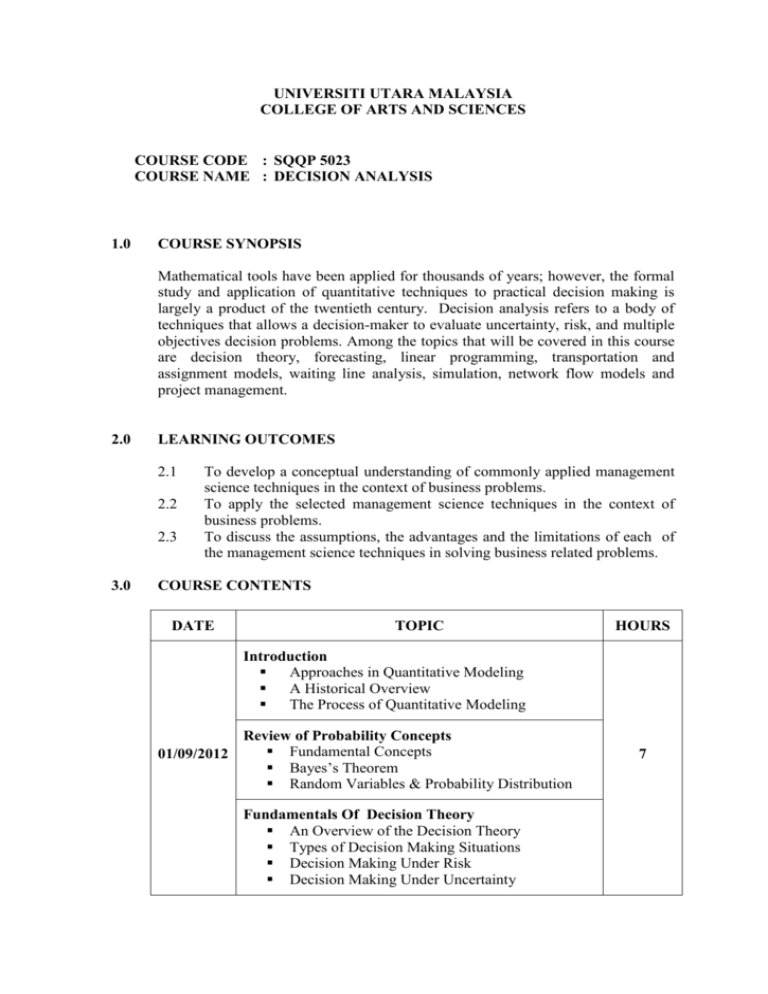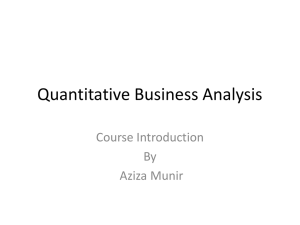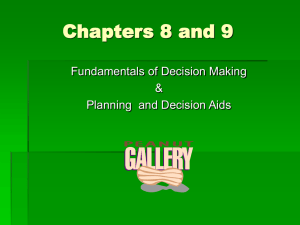course - Rezzen
advertisement

UNIVERSITI UTARA MALAYSIA COLLEGE OF ARTS AND SCIENCES COURSE CODE : SQQP 5023 COURSE NAME : DECISION ANALYSIS 1.0 COURSE SYNOPSIS Mathematical tools have been applied for thousands of years; however, the formal study and application of quantitative techniques to practical decision making is largely a product of the twentieth century. Decision analysis refers to a body of techniques that allows a decision-maker to evaluate uncertainty, risk, and multiple objectives decision problems. Among the topics that will be covered in this course are decision theory, forecasting, linear programming, transportation and assignment models, waiting line analysis, simulation, network flow models and project management. 2.0 LEARNING OUTCOMES 2.1 2.2 2.3 3.0 To develop a conceptual understanding of commonly applied management science techniques in the context of business problems. To apply the selected management science techniques in the context of business problems. To discuss the assumptions, the advantages and the limitations of each of the management science techniques in solving business related problems. COURSE CONTENTS DATE TOPIC HOURS Introduction Approaches in Quantitative Modeling A Historical Overview The Process of Quantitative Modeling Review of Probability Concepts Fundamental Concepts 01/09/2012 Bayes’s Theorem Random Variables & Probability Distribution Fundamentals Of Decision Theory An Overview of the Decision Theory Types of Decision Making Situations Decision Making Under Risk Decision Making Under Uncertainty 7 3 hrs DATE TOPIC HOURS Decision Trees And Utility Theory Decision Trees Probability Values Estimated by Bayesian Analysis Utility Theory 02/09/2012 Forecasting Selecting a Forecasting Method Approaches to Forecasting Qualitative Approaches to Forecasting o Delphi Method o Panel Consensus Statistical Forecasting Methods o Time Series o Regression Methods o Econometric Models Linear programming Formulating linear programming problems The Graphical Method o Maximization Problem 29/09/2012 o Minimization Problem Post Optimality Analysis Linear Programming – Applications Transportation and Assignment Problems Formulating the Transportation Problem Solving the Transportation Problem 30/09/2012 o Stepping Stone Algorithm o MODI Method The Assignment Problem Waiting Lines Analysis The Basic Structure of Queuing The Queuing Models ○ Single-Channel Queue ○ Multiple-Channel Queue 13/10/2012 Applications of Queuing Models Simulation Intoduction to simulation modeling Output analysis Verification and validation 3 hrs 7 7 7 7 DATE TOPIC HOURS Network Flow Models The Shortest Route Problem The Minimum Spanning – Tree Problem The Maximum – Flow Problem 14/10/2012 Project Management Program Evaluation and Review Technique (PERT) PERT / Cost Critical Path Methods (CPM) CPM / Cost 21/10/2012 FINAL EXAM 4.0 7 2.5 REFERENCES Render, B., Stair Jr, R. M., & Hanna, M. E. (2012). Quantitative analysis for management (11th Ed.). Prentice Hall. Taylor, W.B. (2010). Introduction to management science (10th Ed.). New Jersey: Prentice Hall. Albright, S. C. & Winston, W. L. (2007). Management science modeling, Quebec: Thomson Higher Education. Anderson, D. R., Sweeney, D. J., Williams, T. A., & Martin, K. (2008). An introduction to management science: Quantitative approaches to decision making (12th Ed.). Ohio: South-Western College Publishing. Hillier, F. S. & Hillier, M. S. (2003). Introduction to management science: A modeling and case studies approach with spreadsheets. New York: McGraw Hill. Lawrence Jr, J. A. & Pasternack, B. A. (2002). Applied management science: Modeling, spreadsheet analysis, and communication for decision making, New York: John Wiley & Sons Inc. 5.0 TEACHING METHOD This class will be taught through 42 hours of lectures and discussions. 6.0 ASSESSMENT Assessment will be made by examinations, assignments and project work. Coursework 70% Final 30%











